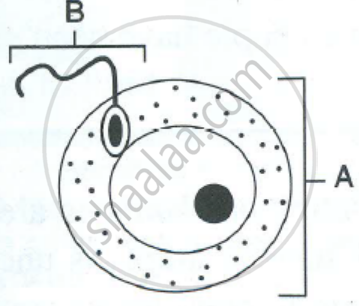Advertisements
Advertisements
प्रश्न
The diagram below represents two reproductive cells A and B. Study the same and then answer the questions that follow:
 |
- Identify the reproductive cells A and B.
- Name the specific part of the reproductive system where the above cells are produced.
- Where in the female reproductive system do these cells unite?
- Name the main hormones secreted by the (1) ovary (2) testes.
- Name an accessory gland found in the male reproductive system and state the function of its secretion.
उत्तर
-
- Ovum
- Sperm
- Follicles of ovary → ovum, Seminiferous tubules in testes → sperm
- Fallopian tube
- (1) Oestrogen, Progesterone,
(2) Testosterone - The glands found in the male reproductive system are the prostate gland and the seminal vesicle.
Function of the prostate gland: The secretion of thin, milky, alkaline fluid enhances sperm motility.
Function of the Seminal Vesicle: The seminal vesicles produce an alkaline fluid. It is combined with sperm to produce spermatic fluid or semen.
APPEARS IN
संबंधित प्रश्न
Explain how the embryo gets nourishment inside the mother’s body.
Write the site of fertilization and the part where the zygote gets implanted in the human female.
The diagram shown below is the longitudinal section of a testis of man. Study it carefully and answer the questions that follow

(i) Label the parts numbered 1 to 3 in the diagram.
(ii) In which part of the testis are the sperms produced?
(iii) State the functions of the parts labelled 1 and 3 in the diagram.
Which part of the human body produces sperms?
Which structure in human female is equivalent to the testes in the male?and in what respect the structures are equivalent?
What is meant by implantation?
Describe in brief the role of testis in human male reproductive system.
Describe in brief the role of prostate gland in human male reproductive system.
Name the Following
What does this abbreviation stand for IUD?
Cryptorchidism is a condition where ______.
